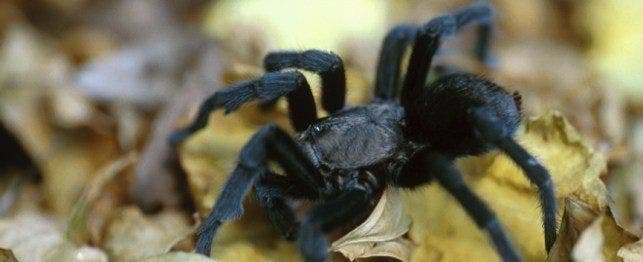
Choosing a Tarantula
Tarantulas are not for everyone, but these large, hairy spiders are gaining popularity as interesting, low-maintenance pets. Despite their Hollywood image, tarantulas are not dangerous, and are often quite beautiful.
As with all spiders, they are venomous, but their bite rarely causes more pain and suffering than a bee sting, and most will not bite unless provoked. Nevertheless, it is best not to handle a tarantula, for their own sake. Because of their fragile abdomens (tail sections), they are easily hurt if dropped from even a small height. And though the venom is usually harmless, it can cause unpleasant reactions if you are allergic to the substance.
In North America tarantulas are found outdoors from Arkansas westward, usually in drier areas. Pet stores may carry one or two species, the most common being the Chilean rose tarantula (Phrixotrichus cala). There are about 800 species worldwide, including the largest of all spiders, the goliath bird eater (Theraphosa blondi) which is big enough to span a dinner plate. A number of specialty dealers offer dozens of different species, which, if properly packaged, can be sent through the mail without harm.
Housing Your Spider
A small aquarium, plastic storage box, or even a gallon-sized glass jar will do for most tarantulas. Because they are excellent climbers, however, a secure top is crucial to keep them from escaping. Just a few air holes in the top will allow enough oxygen to enter, while maintaining the humidity that tarantulas need. Some tropical rain forest tarantulas require a considerable amount of moisture. Take the time to learn about the conditions in your spider’s natural habitat and do the best you can to recreate them.
For the best ground cover for your tank, some recommend dampened vermiculite, a common ingredient of potting soils. A mixture of clean sand and topsoil will also do well. The important thing is to use a material that will retain just enough water to maintain the humidity. Most tarantulas are comfortable between 70 to 85 degrees Fahrenheit, with 80 degrees or so being optimal. Under-the-tank heating pads are the safest way to warm up the spider’s enclosure. These can be found at stores specializing in reptiles. Heating tarantulas with light bulbs or hot rocks can burn or dry them out.
Tarantulas tend to be most active at night and like to hide during the day. Provide some sort of shelter for them. A piece of curved cork bark available in pet stores or a half a small flowerpot on its side will do. If you intend to have more than one tarantula, they should be kept in separate containers; like most spiders, they tend towards cannibalism.
Food and Drink
A spider can survive a few weeks without food, but not without water. A jar lid filled with water is all they need, but a piece of sponge to soak up some of the water makes it easier to drink. Although they can spin silk, tarantulas do not build webs. Instead they stalk their insect meals on foot or wait in ambush. They may eat just about any kind of insect you catch. Avoid catching bugs in areas where you suspect pesticides are used as they will harm your spider. Crickets are sold in many pet stores, usually as reptile food. Adult tarantulas will need only one or two meals a week, and will never overeat. If your spider stops eating, he or she may be about to molt.
Molting and Bald Spots
Tarantulas stop all activity prior to molting, so if you see your spider upside down looking dead, don’t disturb it. In all likelihood, after a week or more, it will emerge from a hatch in its old covering with a brand new, shiny skin. The old skin resembles an intact spider.
Should your tarantula develop a bald spot on its hairy abdomen, don’t be alarmed. As a defense against animals that might eat them, New World tarantulas have a patch of special barbed hairs on their abdomens that cause an itchy rash. (These hairs were once the main ingredient of the itching powders sold in novelty shops.) If stressed or disturbed, they rub their hind legs against their skin to release a small cloud of these irritating hairs. If bothered too often, the spiders develop a bald spot – another reason not to handle them.
Lifespan
Caring for a tarantula may be a long commitment; some females live 20 years or more. Male spiders have much shorter lives, most living a year and a half as adults. Adult males of most species can be identified by the distinctive hooks on the bottom of the third segment of their front walking legs. Their pedipalps, the short appendages on either side of their mouths, are also different. In females they have slender tips resembling legs, whereas in males the ends are blunt and rounded.